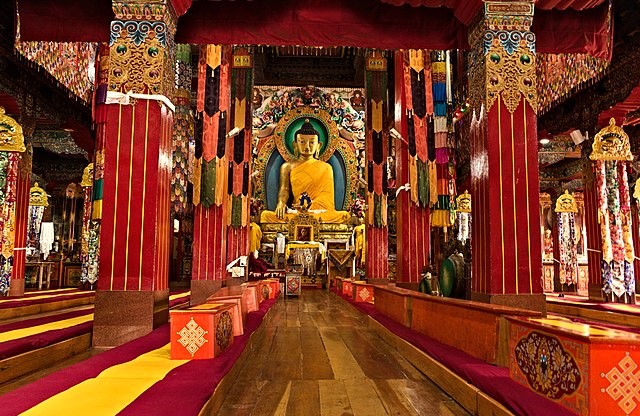Visiting the picturesque town of Tawang in Arunachal Pradesh, India. Tawang Monastery stands as one of the largest and most significant Buddhist monasteries in the world. Known for its stunning architecture and serene surroundings, this spiritual haven attracts thousands of pilgrims and tourists each year. In this article, we will explore the history, architecture, cultural significance, and the overall experience of visiting Tawang Monastery.
A Historical Overview
Tawang Monastery, or Tawang Gompa, was established in the early 17th century, around 1680-1681, by Merak Lama Lodre Gyatso. The monastery was built at an altitude of approximately 10,000 feet and is located about 2 km from the town center. According to local lore, it was founded after a visit from the fifth Dalai Lama, who was seeking a suitable location for a monastery. The site was chosen for its breathtaking views of the snow-capped Himalayas, providing a tranquil backdrop for meditation and spiritual practices.
The monastery has played a pivotal role in the spread of Tibetan Buddhism in the region. It serves as a hub for learning and spiritual guidance, attracting monks from various parts of India, Bhutan, and Tibet. Over the years, Tawang Monastery has endured challenges, including political upheavals and natural disasters, yet it remains a beacon of hope and spirituality for many.
Architectural Marvel
Tawang Monastery showcases a unique blend of Tibetan and Indian architectural styles. The monastery complex sprawls over an area of about 135 square meters, comprising numerous temples, prayer halls, and living quarters for the monks. The main assembly hall, or Dukhang, is adorned with intricate murals and thangkas (Buddhist scroll paintings) that depict various deities and Buddhist teachings.
One of the most striking features of Tawang Monastery is its majestic 28-foot tall statue of Lord Buddha, made of gilded bronze. This statue is the centerpiece of the monastery and is surrounded by smaller statues of various Buddhist figures, creating an awe-inspiring atmosphere for visitors. The monastery also houses a large collection of ancient scriptures and manuscripts, adding to its cultural and historical significance.
Spiritual Significance
Tawang Monastery is not just an architectural wonder; it is a vital center for Buddhist learning and practice. The monastery follows the Gelug school of Tibetan Buddhism and is home to around 450 monks. Daily rituals, prayer sessions, and teachings are integral parts of life in the monastery. Visitors can witness these ceremonies, providing a unique glimpse into the spiritual life of the monks.
The annual Losar festival, which marks the Tibetan New Year, is celebrated with great enthusiasm at Tawang Monastery. The festival features vibrant processions, traditional dances, and elaborate rituals, drawing crowds from the surrounding regions. This celebration not only reinforces the community's cultural identity but also fosters a sense of unity among the people.
Natural Beauty and Surroundings
The beauty of Tawang Monastery is further enhanced by its stunning natural surroundings. The monastery is perched on a ridge, offering panoramic views of the Tawang Valley and the snow-capped peaks of the Eastern Himalayas. The crisp mountain air, lush forests, and vibrant wildflowers create a serene environment that is perfect for reflection and meditation.
Visitors often embark on treks around the monastery, exploring nearby attractions such as the Sela Pass and the beautiful Bumla Pass, which borders China. The region is rich in biodiversity, making it an ideal destination for nature lovers and adventure enthusiasts alike.
Visiting Tawang Monastery
For those planning a visit, Tawang Monastery is accessible via the town of Tawang, which is well-connected by road. The nearest airport is in Tezpur, and from there, one can hire a taxi or take a bus to Tawang. The best time to visit is between October and March when the weather is pleasant and ideal for exploring the region.
Visitors to Tawang Monastery are welcomed with open arms. However, it is essential to observe certain customs and etiquettes while visiting. Dress modestly, maintain silence in prayer halls, and respect the monks and their practices. Photography is allowed in some areas, but it is always best to ask for permission, especially during ceremonies.
Conclusion
Tawang Monastery is more than just a historical site; it is a living testament to the rich cultural and spiritual heritage of the region. Its breathtaking architecture, serene ambiance, and vibrant community make it a must-visit destination for travelers seeking a deeper understanding of Buddhism and its teachings. Whether you are a spiritual seeker or a nature enthusiast, Tawang Monastery offers a unique experience that is both enriching and inspiring.
In a world where chaos often reigns, Tawang Monastery serves as a reminder of peace, spirituality, and the beauty of nature. A visit here is not just a journey to a place; it is a journey within, a chance to reflect on one’s life, and a moment to connect with something greater. As you leave the monastery, the memories of its beauty and serenity will linger long after you return to the hustle and bustle of everyday life.





Comments